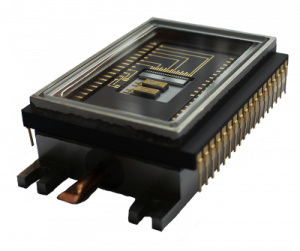
Specifically, the company will develop the performance and sensitivity of the previously supplied CCD69 detector (pictured above). It will use data available from the ESA Aeolus mission, which hosted the first Doppler Wind Lidar in space. The new version could ultimately be deployed in the next generation space-based Doppler Wind Lidar instruments.
“We are proud that unique technology from Teledyne e2v is at the heart of a mission that is improving the quality of weather forecasts around the world and excited to be developing the next generation detector that will produce even better quality, higher resolution data that will provide further improvement to climate science,” said Dr. Paul Jerram, Chief Engineer at Teledyne e2v.
As mentioned, Teledyne e2v provided the CCD69 detector for the Aeolus mission, which is currently in orbit gathering atmospheric wind profiles across the Earth. It launched 22 August 2018.
The company states the mission’s wind observations have had a significant positive impact on weather forecasts. This has led to an interest by EUMETSAT and ESA member states for a possible future operational Doppler Wind Lidar Meteorological mission – Phase A/B1 instrument activities and Phase A operations and ground segment activities are on-going.
Laser beam
It describes the detector’s operation:
“Aeolus’ ALADIN instrument, the first satellite mission to provide profiles of Earth’s winds, works by emitting an ultraviolet laser beam through the Earth’s atmosphere and measuring the reflected return signal from air molecules and particles (aerosols and hydrometeors) in the atmosphere. Teledyne e2v, in collaboration with Airbus Defence & Space and ESA, developed an innovative type of detector that simultaneously measures the travel time and Doppler-shift of the returned ultraviolet laser pulse to resolve the atmospheric wind speed at different altitudes along the instrument line-of sight, from the surface or top of optically thin clouds up to about 30 km altitude. This technique also allows for the detection of thin aerosol and cloud layer and the top altitude of thick clouds.
The returned signal is typically extremely weak, however the detector has the capability to add together a number of returned pulses to improve the accuracy of the measurements. Aeolus is the first satellite of its kind to utilize this type of technology in space.”
Image: ESA/ATG medialab